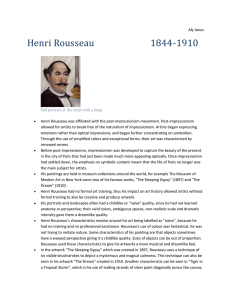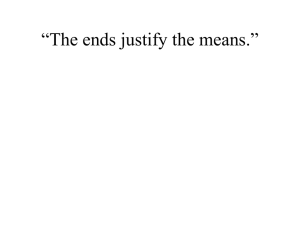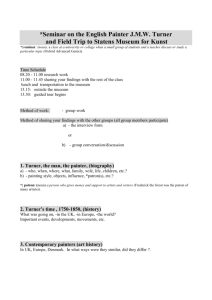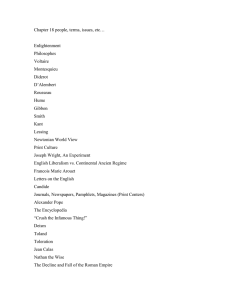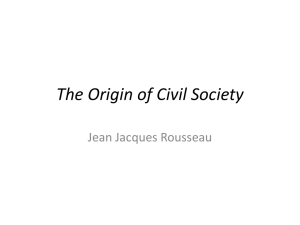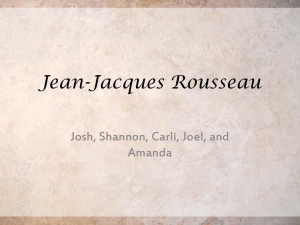HENRI ROUSSEAU
advertisement
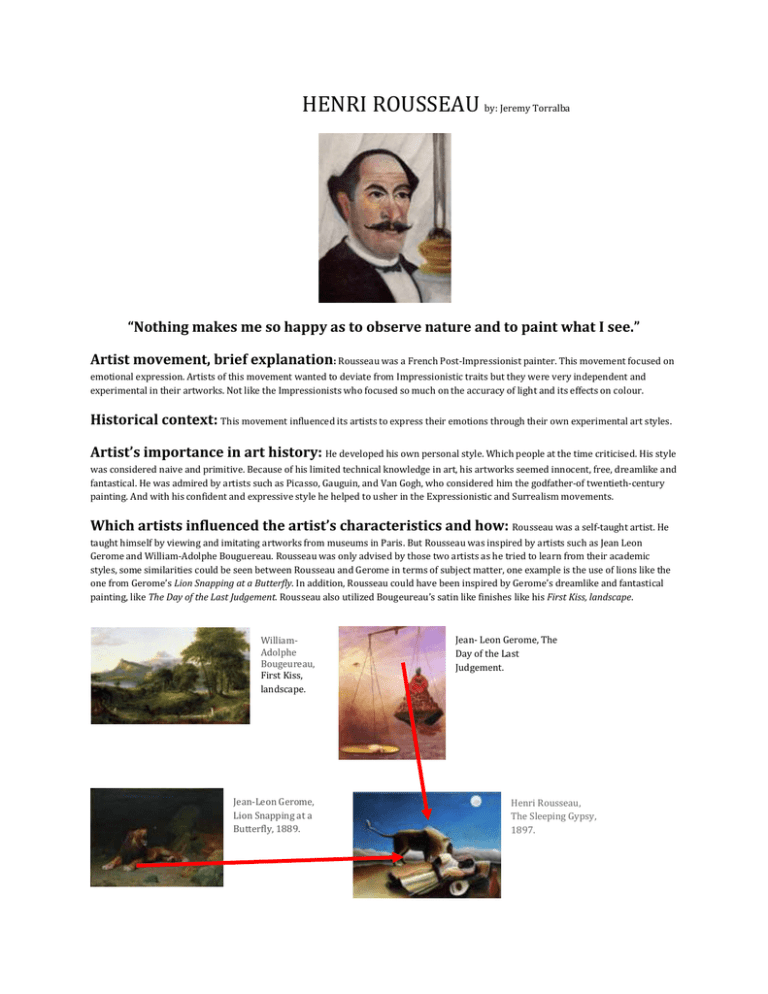
HENRI ROUSSEAU by: Jeremy Torralba “Nothing makes me so happy as to observe nature and to paint what I see.” Artist movement, brief explanation: Rousseau was a French Post-Impressionist painter. This movement focused on emotional expression. Artists of this movement wanted to deviate from Impressionistic traits but they were very independent and experimental in their artworks. Not like the Impressionists who focused so much on the accuracy of light and its effects on colour. Historical context: This movement influenced its artists to express their emotions through their own experimental art styles. Artist’s importance in art history: He developed his own personal style. Which people at the time criticised. His style was considered naive and primitive. Because of his limited technical knowledge in art, his artworks seemed innocent, free, dreamlike and fantastical. He was admired by artists such as Picasso, Gauguin, and Van Gogh, who considered him the godfather-of twentieth-century painting. And with his confident and expressive style he helped to usher in the Expressionistic and Surrealism movements. Which artists influenced the artist’s characteristics and how: Rousseau was a self-taught artist. He taught himself by viewing and imitating artworks from museums in Paris. But Rousseau was inspired by artists such as Jean Leon Gerome and William-Adolphe Bouguereau. Rousseau was only advised by those two artists as he tried to learn from their academic styles, some similarities could be seen between Rousseau and Gerome in terms of subject matter, one example is the use of lions like the one from Gerome’s Lion Snapping at a Butterfly. In addition, Rousseau could have been inspired by Gerome’s dreamlike and fantastical painting, like The Day of the Last Judgement. Rousseau also utilized Bougeureau’s satin like finishes like his First Kiss, landscape. WilliamAdolphe Bougeureau, First Kiss, landscape. Jean-Leon Gerome, Lion Snapping at a Butterfly, 1889. \ Jean- Leon Gerome, The Day of the Last Judgement. Henri Rousseau, The Sleeping Gypsy, 1897. He was also inspired by the jungle setting. So much so that he looked at books about nature and visited zoos and botanical gardens in Paris. Henri Rousseau, Exotic Landscape, 1908. Henri Rousseau, Two Monkeys in the Jungle. The Artist’s characteristics: - Innocence of technique - Naïve and primitive - Dreamlike and fantastical Henri Rousseau, the Sleeping Gypsy, 1897. Henri Rousseau, Surprised! (or Tiger in a Tropical Storm) 1891. Innocence of technique – Not very realistic, the tiger’s face and its right leg, which does not press down the leaves on the ground completely. Naive and primitive – Made up of basic shapes, shapes are visible and defined. Dreamlike and fantastical – The painting’s rightward-motion makes it look like it is actually in motion. Story -The title says it all the surprise is the tiger that is about to pounce. According to Rousseau and his letters, the tiger has the upper hand hence the title, the outcome of the scene is left to the viewer. Henri Rousseau, the Dream, 1910. Innocence of technique – All his figures are very stylistic, especially the figure of the naked woman. The woman’s face is not realistic or proportionate. Naive and primitive – The shapes of the flowers and leaves are very consistent. Also the figure of the woman is not realistic, especially the proportions of her face. Dreamlike and fantastical – The painting has a very inviting look, from the naked woman’s hand gestures to the variety of wildlife that make up the colourful background. Story – According to Rousseau’s letters the woman in this painting is Yadwigha, one of Rousseau’s Polish mistresses. She is lying down on the “divan” or low couch. Rousseau put her in this very surreal jungle setting. Innocence of technique – The figures of the lion and the woman are not very realistic and proportionate. An example of this is the lion’s eye which should be lower and more indented into its head. Another example is the woman’s legs, her legs should be proportionate to the length of her arms, should be longer. Naive and primitive – Very simplistic in detail, the lion’s mane is mainly composed of lines much like the woman’s dress, even though this painting is limited in detail, it makes up for it with its hypnotic colour composition Dreamlike and fantastical – Its richness in colour, hard lines, and flat perspective make it pop, look magical and dreamlike, especially with its night-time setting. Story – According to Rousseau, the woman with the mandolin (stringinstrument) beside her is in deep sleep. And the lion who appears to be preying on her is actually just sniffing her and has no intent of eating her. Works Cited: Brommer, Gerald F. Discovering Art History. Third ed. Worcester, Massachusetts: Davis Publications, Inc., 1997. Print. "Henri Julien Rousseau Biography." Henri Julien Rousseau Biography. The Complete Works, 2002. Web. 06 Oct. 2014.<http://www.henrirousseau.net/>. "Henri Julien Félix Rousseau." Bio. A&E Television Networks, 2014. Web. 06 Oct. 2014.http:<//www.ibiblio.org/wm/paint/auth/rousseau/>. "Biography." IMDb. IMDb.com, n.d. Web. 06 Oct. 2014.<http://www.theartstory.org/artist- rousseau-henri.htm>. Kilaman, Kamelia. "The Sleeping Gypsy: A Painting before Its Time." Culture at Kamelia. Culture Kamelia, n.d. Web. 06 Oct. 2014.<http://cultureatkamelia.wordpress.com/2011/07/22/a-sea-of-artful- unity/>.
